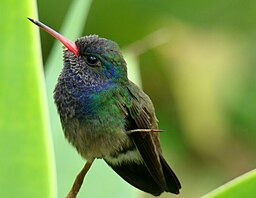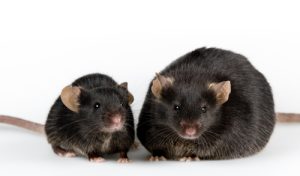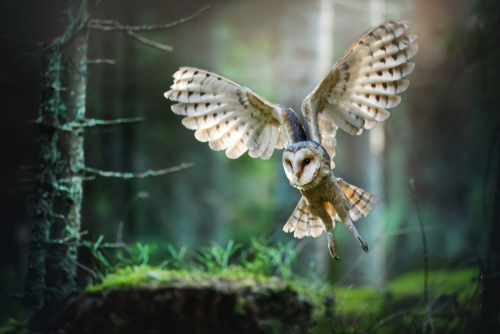
Owls of the World
Did you know there are well over 200 species of owl in the world? They can be found on every continent, except Antarctica. In many cultures, the owl has long been considered a symbol of wisdom and truth, as well as a signifiers of great change. In Native American culture, the owl is considered to be an omen of death as they are thought to accompany the dead to the afterlife.
Owls predominately feed on small mammals, insects, and other birds, though a few species also hunt fish. They are generally solitary birds, whose appearance is typified by an upright stance, a large head, and relatively big eyes. However, it’s the owl’s nocturnal habit that sets it aside from the majority of other bird species.
Here’s a quick rundown of the UK’s five species of native owl:
Barn Owl
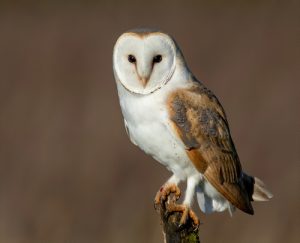
Photo credit: Trevor Partridge/Shutterstock.com
Barn Owls can be most commonly found in open countryside and farmland. They are distributed across the whole of the UK. With fantastic long-distance vision, sensitive hearing and silent flight, the species make lethal hunters. Females of species measures between 30 and 40 cm (12 – 16 in) in length and weigh an average of 350 g. Males are typically 10% smaller than females. Their main diet is small mammals such as rats, voles, mice and shrews. The distinctive owl is particular known for its eerie high-pitched screech.
There are currently thought to be up to 12,000 breeding pairs of barn owls in the UK. This represents a rise of almost 300% on the 1980s population. Numbers of which were gradually depleted over the previous 50 years, due to changing agricultural practice.
Tawny Owl
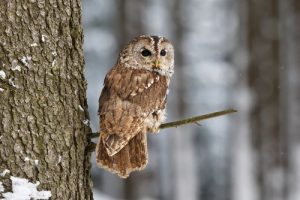
Photo credit: petrrd/Shutterstock.com
Tawny Owls are distributed across England, Scotland and Wales, though usually not found in Northern Ireland. They are generally found in woodland, though sometimes in parks and large gardens. The Female of species generally measures between 35 and 42 cm (14 – 17 in) in length and weigh an average of 500 g. Males are typically 25% smaller than females. The tawny owl mostly feeds on small rodents but their prey can also include small birds, frogs, worms and insects.
The tawny owl is by far the UK’s most abundant species of owl. The current population is estimated at up to 50,000 pairs. Nonetheless, the tawny owl is listed as a Species of Conservation Concern in the UK, since its population and range has somewhat declined in recent years.
Little Owl
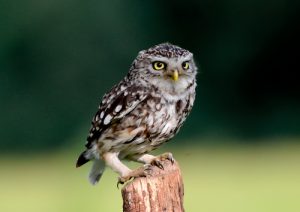
Photo credit: morgan stephenson/Shutterstock.com
First introduced to the UK in the late 19th century, unsurprisingly, the Little Owl is the country’s smallest owl. It can be found across England, Wales, and southern Scotland. However, it is most common to the Midlands, East Anglia and North West England. Its favourite habitat is lowland farmland, small woodlands, parks and orchards. Both male and female little owls measure around 22 cm (11 in) in length and weigh around 180 g. Its diet predominately consists of insects, though it also eats worms, small rodents and birds.
The British little owl population is currently in sharp decline. One estimate suggests the population fall of the species may as much as 65% since the early 1990s. The main driver behind the little owl’s UK decline is thought to be changes to agricultural practice. The bird has also experienced an 11% reduction in it range across England and Wales since the 1960s. Current best estimates of the UK population of little owls is between 3,700 and 5,500 breeding pairs.
Long-eared Owl
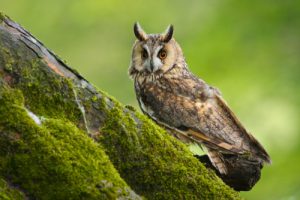
Photo credit: Helen J Davies/Shutterstock.com
While The Long-eared Owl is one of the UK’s rarest owl species it is distributed widely across the whole of the country. The species it is thought to be most abundant in Northern Ireland. The long-eared owl’s favoured habitat is both deciduous and coniferous woodland, though it commonly hunts in open countryside. Its diet largely consists of rodents and small birds. Female long-eared owls generally measure between 35 and 40 cm (14 – 16 in) in length and weigh up to 430 g. Males are typically 10% smaller than females.
The long-eared owl is the most nocturnal of the British owl species’ and seldom ever seen during daylight hours. Thus, the current UK population of the bird is difficult to ascertain to any degree of great accuracy. Additionally, UK populations may joined by migratory long-eared owls from Europe during particularly harsh winters. Best estimates suggest that the bird’s UK numbers are somewhere between 1,500 and 4,500 breeding pairs.
Short-eared Owl
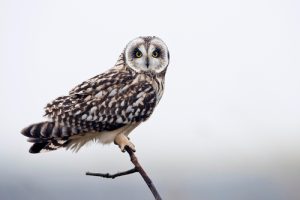
Photo credit: Helen J Davies/Shutterstock.com
The short-eared owls breeding population can primarily be found in the North of England and Scotland. Their favoured habitat is moorland, dunes and heathland. The bird’s diet consists almost entirely of small rodents. Female short-eared owls generally measure between 34 and 40 cm (11 – 16 in) in length and weigh up to 350 g. The males of the species are generally a little smaller than females.
Short-eared owls are different from other owls in as much as they primarily hunt during dusk and dawn. They can also be quite often seen actively hunting during the day. The country’s current breeding population of short eared-owls is estimated at 620-2,200 pairs. However, the resident population is normally boosted by migrant birds during the winter months. In the UK, the short-eared owl population is currently falling, mostly attributed to loss of habitat. Thus, their conservation status in the UK is currently viewed as being of ‘concern’.
Did You Know?
Did you know that the collective noun for a gathering of owls is a ‘parliament’?
Header photo credit: Krasula/Shutterstock.com
